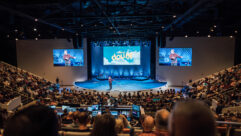Village Hall Gets Cutting-Edge AV
Replacing a 40-year-old community building with a new boardroom and an adjacent television studio revitalizes a Chicago suburb’s Village Hall.
A look at lightingVideo considerationsAudio analysisExceeding expectations
CHALLENGE: Design a facility that serves double duty as a boardroom and local television studio, seamlessly integrating audio, video, and lighting between the two spaces.
SOLUTION: Install a control room between the two facilities to house the customized control system that serves as the brains of both operations, enabling television-quality video, audio, and lighting throughout the entire facility.
NOT SO long ago, speakers at village meetings for the Village of Mount Prospect, a suburb of 56,000 located outside of Chicago, used to lug in 3-foot by 4-foot presentation boards as a visual aid to deliver information to the audience and board members. Built on an old shuffleboard court, the 40-year-old boardroom had terrible acoustics, bad lighting, and poor camera angles. Tired of the overcrowded space and out-of-date equipment that left the group somewhat AV-impaired, the Mount Prospect Board of Trustees decided to tear down one of its existing facilities to build a new Village Hall with an integrated boardroom in its place as well as an adjacent space for the Village’s small broadcast television station (MPTV) — with a shared control room in between (see sidebar for more details on the control panel).
“We were basically challenged by our elected officials to bring up the quality of our programming without making it so complicated that you had to have professional producers to run the thing,” says David Strahl, assistant Village manager, who also served as construction manager on the project.
Thanks to a progressive vision by Village board members and staff, complemented by a design-build AV system developed by Swiderski Electronics, an AV systems integration firm located in Itasca, IL, the group got its wish when it opened the doors to its new Village Hall in August. Swiderski designed the boardroom with two Sony VPLFX51 video projectors, audio reinforcement via hanging and wall-mounted speakers from JBL and Soundtube, an advanced lighting system, four pan-tilt-zoom Panasonic AW-E600 video cameras, and a custom lectern, which complies with ADA regulations. This podium features a preview monitor, a gooseneck microphone, laptop connectivity, a pullout drawer with a document camera, and a pullout drawer for wheelchair access with an attachable secondary microphone. In addition, each of the board members’ seats at the dais (conference table) features laptop connectivity, a gooseneck mic, a swivel-mount articulating LCD monitor, and push buttons to mute the mic or switch video sources.
Although in its previous quarters the eight board members sat practically on top of one another, they now preside over a 40-foot-long dais with 6 feet in between them. Keeping in mind that MPTV would be broadcasting village meetings live as well as playing back prerecorded material, camera angles and lighting quickly became an issue for Swiderski when designing an effective AV approach for this board-room, which is 60 feet wide, 40 feet deep, and 22 feet high.
According to Russell Roberts, manager of computer-aided design at Swiderski, lighting in the high, shallow space proved to be one of the greatest challenges from an architectural standpoint. This scenario featured real people and real issues. Therefore, the AV design had to make participants feel comfortable on camera. Because the client wanted to achieve broadcast quality video on the cameras, Roberts says the obvious answer was studio lighting. However, because the Village didn’t want equipment visible on camera or a typical TV studio environment with flashy lights that might intimidate subjects, Swiderski had to come up with another alternative.
Creating Customized Control
Among others, Swiderski used the following AMX devices to achieve the solution: one AMX NXF 2RU NetLinx CardFrame, an NXC-ME260 NetLinx Master260 Ethernet card, two NXT-CA12 Modero color active, 12-inch tabletop touchpanels, and an NXD-CA12 Modero color active, 12-inch flush-mount touchpanel.
At the heart of the Mount Prospect project are customized AMX control panels, which make AV hardware and software components come to life. Programmed by Swiderski, the control system allows the director in the control area to handle all audio and video needs through a multitude of presets.
The system features a main presentation mode page as well as a source selection page for which laptops can be used to connect to either of the two front-projection systems. The Village has one control module that runs four cameras, and every camera has 50 presets. When designing the control panel, Swiderski ensured that users could access any function of the system with three or less button pushes and no more than two page flips or pop-ups.
Dan Tehan, an application technician at Swiderski and an AMX Certified Expert (ACE), says the biggest challenge in creating the touchpanel was putting 22 sources and five destinations on a touchpanel in a way that would not be intimidating to the user. “We used 12-inch Modero panels because of their high resolution, enabling us to leave certain icons on the screen at all times and only covering a portion of the screen with pop-up pages,” he says. “By leaving some elements stationary like the Village symbol in the top left and the destination buttons along the bottom, it’s much less disorienting to use the panel.”
Because this project was design-build, Tehan had access to the architectural layout of the room when designing the control panel. “I imported a line drawing of the dais, manager’s table, and lectern and overlaid icons for the laptops and video inputs,” he says. “This makes it much easier for the meeting coordinator to figure out which inputs he/she wants to use, and gives the panel a much more organized look. The destination buttons on the bottom of the page reflect the source being sent. This way, the control panel operator doesn’t have to check through all of the monitors to see which source is live, but can tell at a single glance at the touchpanel.”
Roberts knew he needed key lights, fill lights, and back lights on each of the people sitting at the dais, as well as Village staff sitting at a secondary table area and presenters at the lectern. Working with a lighting designer, he proposed a LSI track lighting package with 500 W fixtures — each controlled by its own dedicated dimmer — suspended from the ceiling. “We specified 16 light fixtures across the front of the main dais alone just to light the board members, so we had to provide a track light fixture that had a louver on it,” he says. “That way, each person at the dais only sees his/her dedicated lighting instead of the whole bank of lights.”
The last part of the lighting puzzle involved pendant lights. “We had a 22-foot ceiling and pendant lights at 14 feet, so we had to strategically place each track light fixture to project light over and under some of the pendant lights near the dais to make sure people were lit properly,” Roberts says. “It was very hard to create because every path of light from each track light fixture had to be looked at individually to make sure it went over and under the pendant lights and reach the subject without any shadowing. But after a lot of design work and coordination, we got it right. We also installed “Intelligent Raceway” distributed dimming strips in the studio, which can be repositioned on the pipe grid as required.”
Blending the cameras and projectors into the room’s aesthetics also proved to be tricky, says Paul Swiderski, executive vice president/director of engineering. “People don’t like to see things hanging out. They want the system to be transparent,” he says. “Working these technologies into the architectural design work while making them as user-friendly as possible was challenging.”
There are two basic systems integrated into the boardroom: a high-resolution VGA system that enables the latest computer inputs to be presented to the board and two large-screen projection systems that allow the audience to view the presentation from the podium on two 6-by 8-foot Da-Lite video screens. “From the podium position, an individual can bring in a laptop, present PowerPoint or digital images, and the audience would be able to see them on the screens,” he says. “The participants at the dais could also see a high-resolution quality image of what the presenter was providing on their individual LCD monitors. From an RGB standpoint, the presenter has many inputs available so they could pull up images as well as present presentations or Word documents that needed to be refined, detailed, or reviewed by the board, so it’s a very interactive system.”
According to Howard Kleinstein, cable production coordinator, who oversees the operations of the Village’s two access channels, one unique aspect of the video approach was audience support. “We have two projectors in the room, and we can assign different things to each of them,” he says. “So if someone has a graphic up we can leave it up on one projector and follow the action of who’s speaking on the other. Plus, the board members can switch back and forth between the right and left projector on the screen in front of them.”
Televising the meetings is made possible by four pan-tilt Panasonic AW-E600 convertible cameras equipped with a Buhl 356MCZ087 long-throw zoom lens strategically placed throughout the room.
Switching gear from Extron was necessary to achieve the video and audio integration between facilities, including four VGA and audio switchers, an MAV 62 AV composite video and stereo audio matrix switcher, a DVS 204 digital video scaler, a CrossPoint Plus 88HVA matrix switcher, and a VSC 700 high-resolution computer-to-video scan converter with genlock, among others.
To achieve broadcast quality AV, audio was equally important to the customer — so much so that the Village brought in an outside acoustical engineer at a cost of $3,000 to evaluate the room and make sure the sound would perform as intended, says Strahl.
The new sound system eliminates many of the sound quality issues that plagued the former Village facilities. The projection systems, volume levels of speakers and microphones, and video source selections are all controlled from a single touchpanel control system programmed by Swiderski. Some of the major audio equipment installed includes: 17 Shure MX418/S supercardioid 18-inch gooseneck condenser microphones, two Sennheiser E845 Evolution wired, handheld dynamic supercardioid microphones, three Polycom Vortex-EF2280 multi-channel AEC noise cancellers with automatic mic and matrix mixers, two Stewart Audio CA-400 and two CVA-7400 1RU two-channel amplifiers, and four JBL Control 28-WH 8-inch, two-way surface mount speakers.
FOR MORE INFORMATION
AMXwww.amx.com
Buhlwww.navitar.com
Da-Litewww.da-lite.com
Extronwww.extron.com
JBL Prowww.jblpro.com
Panasonicwww.panasonic.com
Polycomwww.polycom.com
Sennheiserwww.sennheiserusa.com
Shurewww.shure.com
Sonywww.sony.com
Soundtubewww.soundtube.com
Stewart Audiowww.stewartaudio.com
Roberts explains that sound reinforcement was an issue. “You have these 22-foot-high ceilings, and you don’t want to put speakers up at that height because you’d have to turn up the volume and blast everyone away, so we put the speakers at the same elevation as the pendant lights so that they all blended together,” he says. “Then we painted them white to match the pendant light fixtures, which were about 4 feet in diameter, so we got a nice sound level at the level of the audience as opposed to trying to put sound through the whole space.”
Swiderski chose four Soundtube RS62I-T32 speaker systems to provide low-level distribution so that everyone could understand what the board and presenters were saying through the wireless mics.
According to Strahl, the Village is very happy with the flexibility of the final AV solution, all of which is directed via the shared control room. The total cost of the AV system was more than $305,000 (not including lighting), plus almost another $86,000 for additional electrical work that was necessary to support the system. “We’re able to do more things as well as increase the quality of the way that the board meetings run,” he says.
Ellen Parson is a contributing writer and editor for Pro AV magazine. She can be reached at [email protected].










